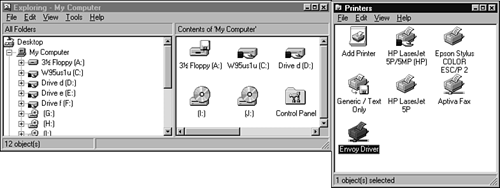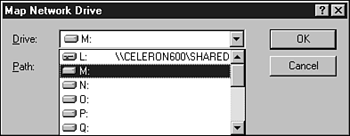Using Shared Resources
| < Day Day Up > |
| With any type of network, the user must log on with a correct username and password to use any network resources. With a dedicated server, such as Novell or Windows NT/2000/Server 2003, a single username and password is needed for any network resource the user has permission to use. On a peer-to-peer network, such as a Windows 9x/Me network, additional passwords might be required for each of your resources. On a dedicated server network, such as Novell NetWare or Windows NT/2000/Server 2003, a single password provides a specified user with access to all the shared resources that a particular user is permitted to use. This is called user-level security. A Windows 9x/Me peer server connected to a dedicated server can also use the dedicated server's list of users to control access. User-level security controls a wider range of activities on a system than does share-level security. A peer server used on Windows 9x/Me uses a username and password for initial access, and can also use a separate password for each shared resource. This is called share-level security and is harder to maintain. A peer server has three security levels:
Information can be copied from a shared drive or folder if the user has read-only access; to add, change, or delete information on the shared drive or folder, the user needs full access. Network printing is performed the same way as local printing after the network printer driver software has been set up on the workstation. You can identify shared resources with Windows by using Explorer or My Computer. On a system that is sharing resources with other users, a shared drive, folder, or printer will use a modified icon with a hand, indicating that it is being shared (see Figure 21.13). Figure 21.13. The Windows 9x Explorer (left) and Printers folder (right) display shared and nonshared resources. The hand icon indicates which drives and printers are shared with other computers. To use a shared resource on a peer server that uses share-level security, the user must provide the correct password for any password-protected share. To use a shared resource on a network that uses dedicated servers with user-level security, the user must log on to the network. The administrator of the server or network has already assigned access levels and permissions to each user or group , so the user can immediately begin using shared resources as permitted. Shared drives and folders can be referred to by a mapped drive letter, a Universal Naming Convention (UNC) name, or a fully qualified domain name (FQDN). Each of these is explained in the following sections. Mapped DrivesWindows enables shared folders and shared drives to be mapped to drive letters on clients . In the Windows Explorer/My Computer, these mapped drive letters will show up in the list along with the local drive letters . A shared resource can be accessed either through Network Neighborhood (using the sharename) or through a mapped drive letter. Drive mapping has the following benefits:
To map a shared folder to a drive with Windows Explorer, follow this procedure:
Shared folders can be accessed by either their mapped drive letters or by their folder names in Windows Explorer. The Universal Naming Convention (UNC)The Universal Naming Convention ( UNC ) is designed to enable users to access network resources without mapping drive letters to network drives or specifying the type of device that stores the file or hosts the printer. A UNC name has the following structure in Windows: \servername\sharename\path\filename A typical UNC path to a document would resemble \Aopen\O\NetDocuments\this_doc.doc What does this mean in plain English?
UNC enables files and printers to be accessed by the user with Windows applications. Windows 3.x and MS-DOS users must map drive letters to shared folders to access files and must map printer ports to shared printers to print. Because only 23 drive letters (maximum) can be mapped, UNC enables network resources beyond the DZ limits to still be accessed. Some Windows applications will display the UNC path to a file even if the file was accessed through a mapped drive letter, and other Windows applications will refer to the UNC path or mapped drive letter path to the file, depending on how the file was retrieved. Fully Qualified Domain Names (FQDNs)TCP/IP networks that contain DNS servers often use FQDNs to refer to servers along with, or in place of, UNC names. The structure of an FQDN is Name-of-server.name-of-domain.root-domain For example, a server called "charley" in the selectsystems.com domain would have an FQDN of charley.selectsystems.com If you want to access the shared Docs folder on charley.selectsystems.com , you would refer to it as \charley.selectsystems.com\Docs You can also use the IP address of the server in place of the servername. If 192.10.8.22 is the IP address of charley.selectsystems.com , you can access the Docs folder with the following statement: \192.10.8.22\Docs You can use either UNCs or FQDN along with the Net command-line utility to view or map drive letters to shared folders. |
| < Day Day Up > |
EAN: N/A
Pages: 310

